My husband and I just returned from our 22-day honeymoon in Japan, and I wanted to conclude our adventure with a little 'accessibility assessment'.
We are from Belgium, and I need a manual wheelchair for longer distances, which means I can walk and do a few steps/stairs. Perhaps this information could be useful for a select audience, but perhaps also an interesting read for others.
Hopefully this will help even a few adventurous souls out there, abled and disabled alike.
Get my free Japan Travel Bulletin:
Accessible Japan Sightseeing Tips
by Cati Van Reeth
Accessible Japan sightseeing - our 22-day itinerary
As we were researching our trip, we found little info that could properly prepare us for the accessibility in Japan, but we were very confident we had picked the right country.
We were in Tokyo for a total of 10 nights, Kyoto for 5 nights, Nara for 1 day, Osaka for 3 nights, Kobe for 1 day and Lake Kawaguchiko for 2 nights. Our itinerary was completely personal and tailored to our wishes and expectations. So, without further ado, here are our thoughts about what we experienced in beautiful Japan.
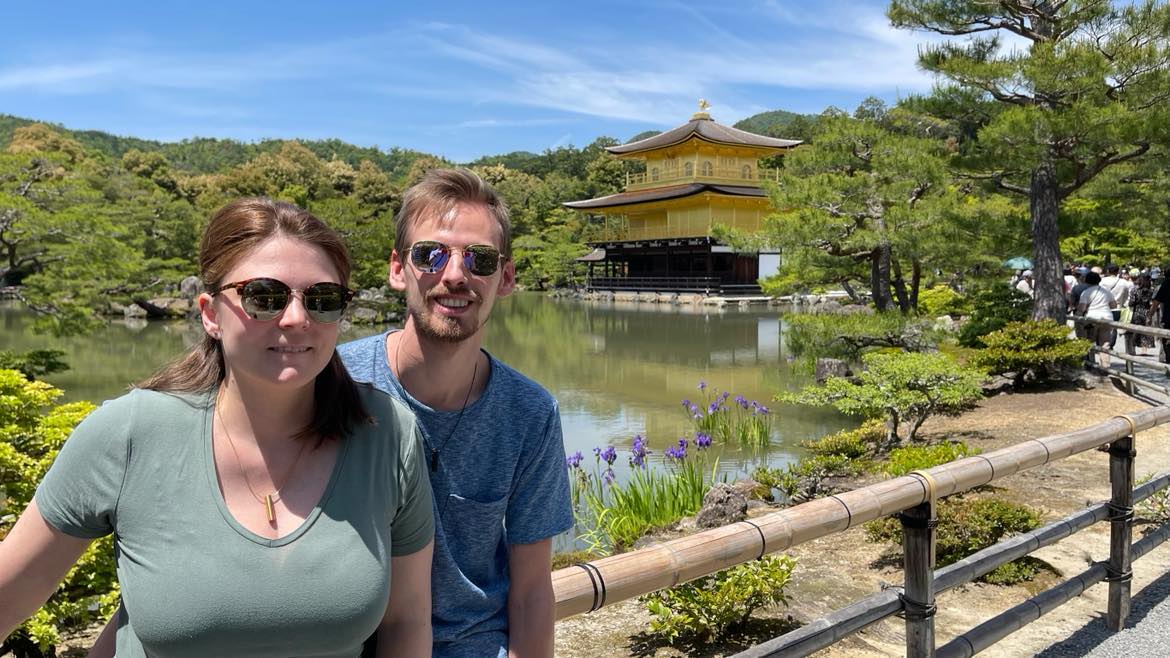
Cati Van Reeth and her husband at Kinkaku-ji Temple (Golden Pavilion), Kyoto | Photo: Cati Van Reeth
We flew with Japan Airlines (JAL) and had one overlay stop at Helsinki, the service was beyond amazing. We decided to book JAL's Premium Economy seats, as it was our honeymoon and wanted to treat ourselves. Totally worth it, in my personal opinion. The assistance during overlay was excellent, as we were fully informed about the whereabouts of the wheelchair we brought along.
Strategically-located hotels
Once in Japan, our hotels were strategically located near the stations we knew we were going to pass frequently. All of them were fully wheelchair accessible, but we researched that beforehand. Also the train stations and subways we used were all wheelchair accessible with elevators. However, sometimes the elevators are not so easy to find.
This means sometimes having to enter a nearby store (as many large stores in cities are directly connected to the subway system via their basement levels), using their elevator to the first basement level, and then finding another elevator that takes you to the subway tracks.
Our accommodation - where we stayed
Google maps is your best friend in Japan and it also has a specific Public Transport-mode where you can instruct it to avoid stairs. So it’s definitely worth downloading separately on your smartphone before you enter the country. You’ll have to take into account the extra time it will take to find your entrance. Fortunately, the trains in Japan are super punctual, and also frequent. Missing your train doesn’t really exist, there will likely be another one shortly.
[If you'd like more information on using public transport in Japan, check out this post.]
Don’t hesitate to ask for help
Also, don’t hesitate to ask for help, especially if you’re travelling alone (yes, we think travelling alone with a wheelchair is possible in Japan). The person who is stationed at the wider entrance gate for wheelchair users, where you scan your IC-card (pre-paid travel smartcard) has proven to be the most reliable source of information. They will, nine times out of ten, ask you what your final destination is, and they will arrange for someone to either assist you in the station itself, or at least arrange a ramp for you to enter the train in the designated area.
On metro trains every few compartments there’s an area without seats for wheelchair users, same with buses where they will fold up two seats to make room. One Sunday, we were travelling from Lake Kawaguchiko Station to Ikebukuro Station in Tokyo. We had to switch trains two times along the way.

Lake Kawaguchiko Station with Mt. Fuji in the background
We couldn’t believe it when we realised that the Kawaguchiko station workers had arranged for other station workers to be waiting for us with a ramp at the exact door we had entered the train. All the way to Ikebukuro, we didn’t have to worry about a single thing and we could enjoy the views of the countryside.
SEE ALSO: How The Japanese Anticipate Other People’s Needs
An incredible source of stress and a breath of fresh air
Travelling with a wheelchair has always been an incredible source of stress for me personally, because even in my own country, you just can’t relax and rely on the services. For an able person, it’s probably very hard to imagine the inability to simply go wherever you need to. The freedom to decide on the spot. The small gaps and the 'one' step that keep you from being on time, to freely explore.
That is why Japan has been like a breath of fresh air to us.
To see what is possible without having to change the whole infrastructure. I always say that I’m only as limited as my surroundings make me, and in Japan I felt like there were no limits to what we could do. I did have my husband to push my chair, but many of the station workers (and even fellow passengers!) offered to help. Even the buses have the most mindful drivers who will definitely take good care of you.
In short, I do recommend Japan as a destination if you’re a person with any type of physical disability.
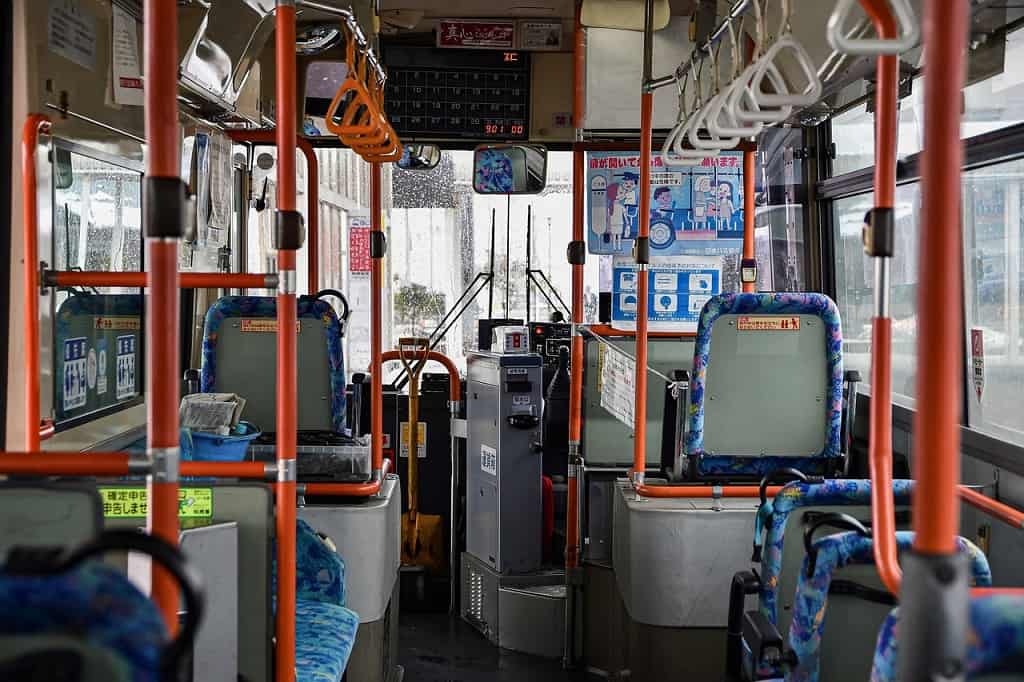
Many city buses are wheelchair accessible and have priority seating for wheelchairs
Being treated with respect and dignity
The Japanese treat you with the utmost respect and dignity, it’s very refreshing.
One time, one of the bolts from my wheelchair went missing and the front wheel was getting loose. Over time it would have come off completely without the bolt holding it in place. So we stepped into the first hardware store we could find in Kyoto and a very nice gentleman used a Makita drill to set us up with a shiny new bolt and fix my wheel. We offered to pay for it and his services, but he declined payment. Our grateful hearts were filled with pure joy about this gesture by, as we have dubbed him, 'Makita man'!
Onto the sightseeing and activities...
Our first week exploring Tokyo
The first week we spent in Tokyo, and it was nothing short of amazing.
We were happy to find that most shrines are wheelchair accessible, which was something I was very worried about when we were planning. Ramps or elevators are usually around somewhere. This being said, be aware that when you wish to enter inside buildings (the part where everyone removes their shoes) you will probably have to settle for looking from a distance (as a tourist anyway, perhaps a disabled Japanese person will be able to enter somehow).
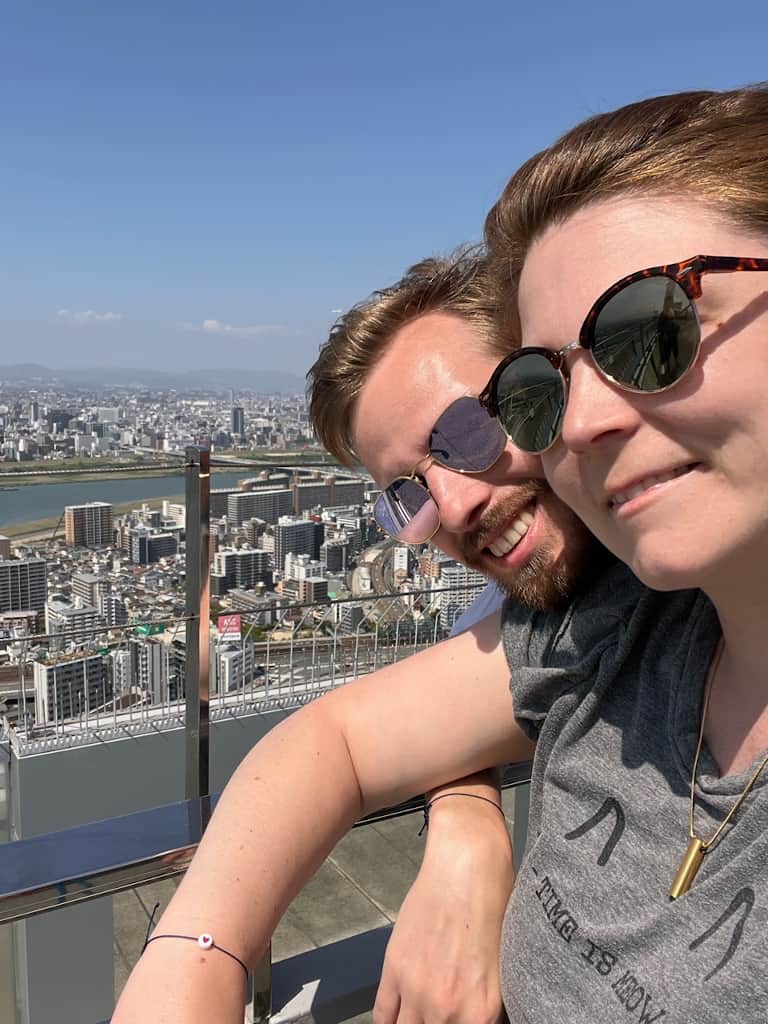
Cati Van Reeth and her husband | Photo: Cati Van Reeth
In the city there will be lowered sidewalks at crossroads, as you would find in most cities anywhere. In the countryside, however, sidewalks will most likely simply be absent. Everyone walks on the road. At least, that eliminates the problem of getting caught on the edge of the sidewalk. Many restaurants require you to go up stairs to get in, because they’re simply located on the second or third floor, or are so cramped that you can’t park your wheels anywhere. But you can rest assured there are many alternatives to whatever you’re craving.
There’s a chance you won’t be able to dine at 'that one place you saw on Instagram', but take it from our experience, the place across the street will probably have a bunch of other things you’ll definitely like.
But that’s the thing with popular places, people will line up for sometimes hours while there’s perfectly great alternatives around. We, for one, never lined up for anything except for Universal Studios Japan. We rarely made reservations in advance either, simply because we wanted the freedom to explore day to day, depending on the weather and such.
Accessibile Japan sightseeing tips for popular spots
Here are some of the experiences we had and places we visited, worth telling you a little more about. Obviously we did a great many other things on our three week trip but I decided to select a few topics to keep things relevant.
Tokyo accessible sightseeing tips
Tokyo Skytree
There are four large elevators when visiting Tokyo Skytree and you will be able to ride along with the other visitors. The observation deck is spacious, so even with a lot of visitors you will still be able to move around. People will most likely make room for you to see the view. There's also a floor window to look down from, which is also pretty cool!
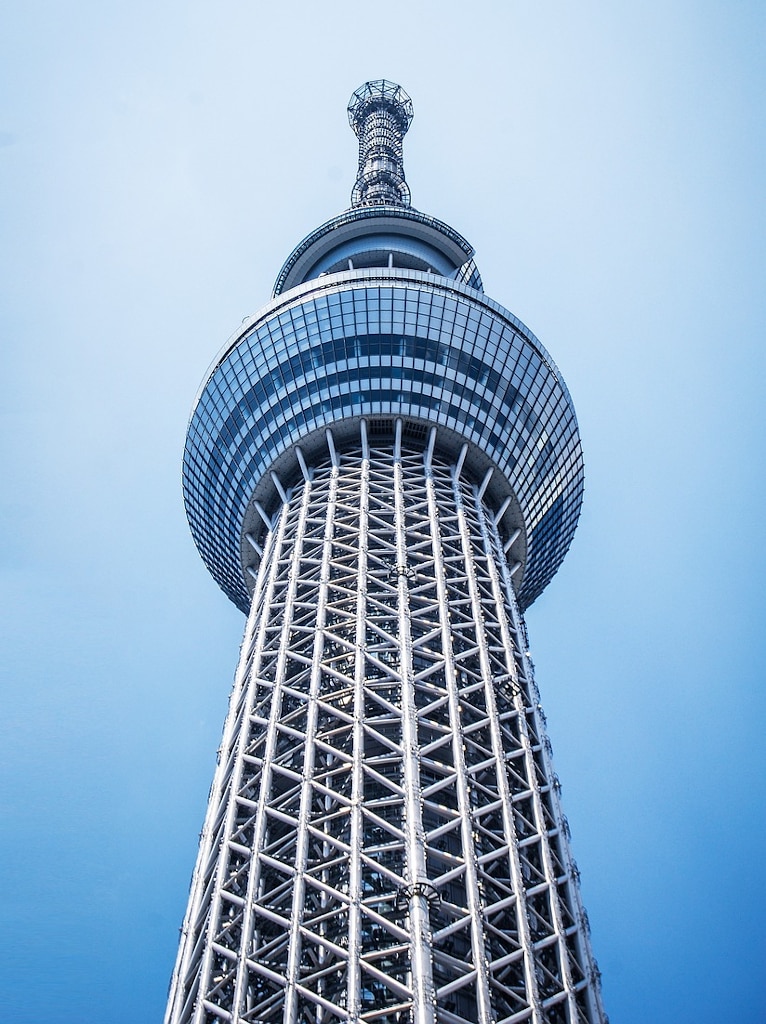
Tokyo Skytree is wheelchair accessible, including the spacious observation deck
Meiji Shrine
The way to the Meiji Shrine, through the park, was a wide gravel road with a strip of pavement at both ends of the road. This pavement is used by bikes and strollers, and is also useful when you're using a wheelchair. At the shrine itself there are concrete pavements everywhere, with ramps wherever there are steps, so that is completely accessible to wheelchairs.
Gyoen National Garden
This garden, like any authentic Japanese garden, has gravel paths all over and only a few parts are paved. If you have a strong driver you can get around Gyoen National Garden fine. There also was a fully accessible indoor botanical garden at the park, which is a nice break from the gravel roads.
Senso-Ji Temple
The Senso-Ji Temple grounds are fully paved and accessible to all. The temple itself has an elevator for wheelchairs and strollers, it's on the left side when facing the building. Once you exit the elevator you will be at the level with all the other visitors is and you'll be able to toss a coin and say a prayer.
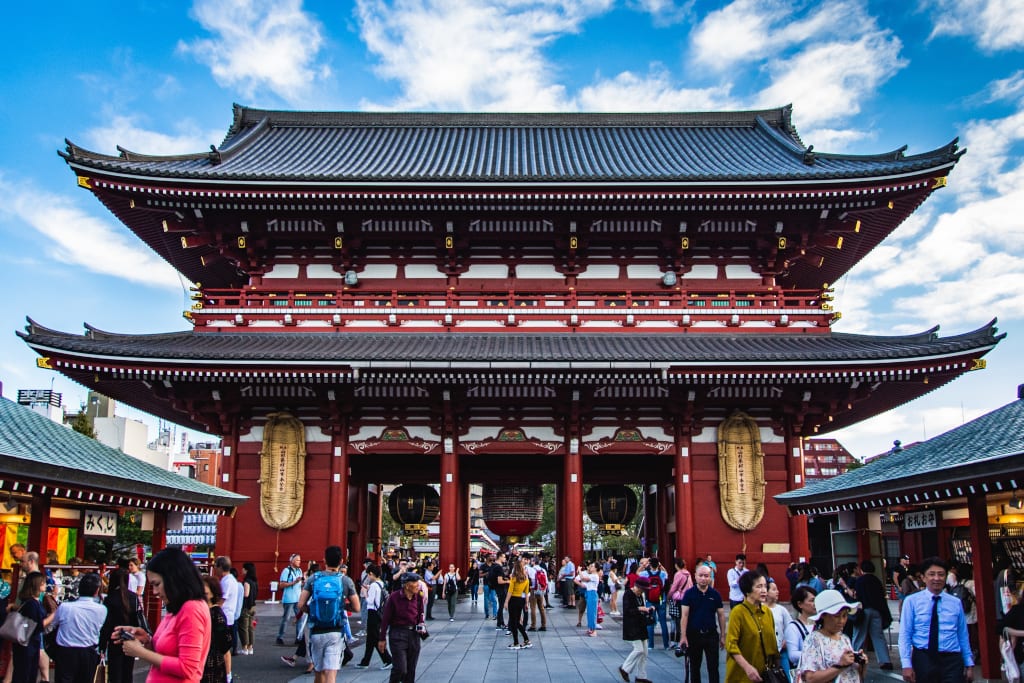
The Hōzōmon (Treasure-House Gate) is the inner of two large entrance gates leading to Sensō-ji
Mameshiba café at Takeshita street
Mameshiba café at Takeshita street is a dog cafe. They had an elevator, however the space was very cramped and you can’t take the chair into the room where the dogs are. You have to go in and get a reservation for that day, they’ll give you a time when to come back to avoid overcrowding the already crowded room. The dogs seemed uninterested in the many guests they had to entertain, which is very understandable. We did have concerns about the dogs' wellbeing.
Zojoji Temple
Zojoji Temple is dedicated to miscarried and stillborn children, where many of the children's effigies are further along a corridor that you can only reach through stairs. So about 70% is accessible (depending on your mobility).
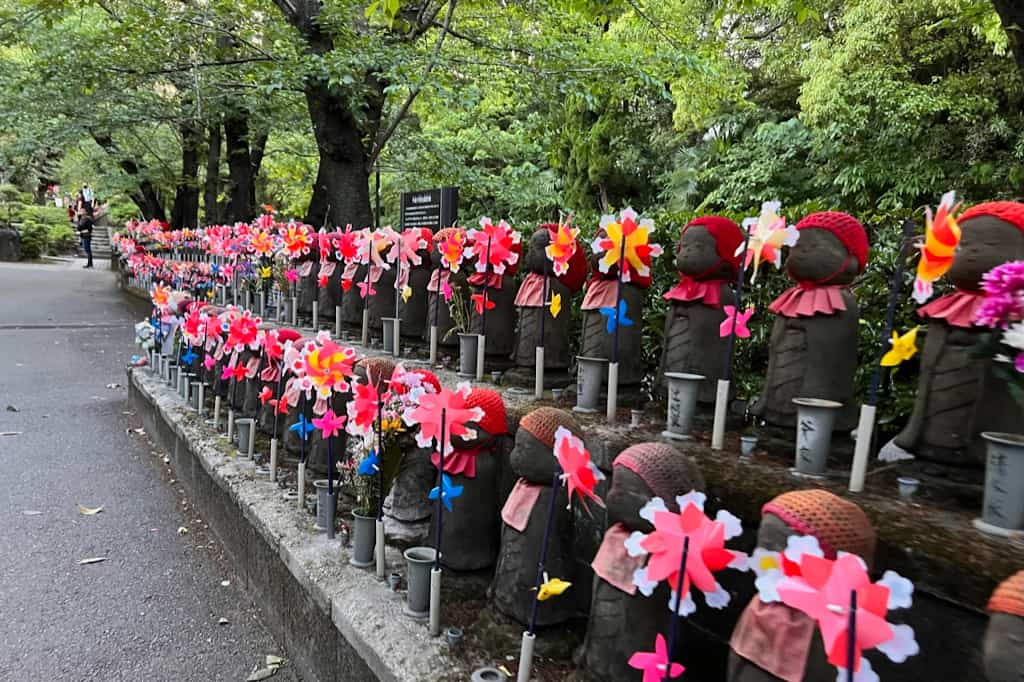
The effigies at Zojoji, you can see the stairs in the back that lead to more rows of statues | Photo: Cati Van Reeth
Kyoto accessible sightseeing tips
Kiyomizu-dera Temple
Kiyomizu-dera Temple is a must see when you’re in Kyoto. It will most likely be crowded, and this will cause inconveniences and many oopsies when people start bumping into you because they’re understandably only paying attention to the views and not the road, on the way up your own views will mostly consist of butts and crotches, all the good stuff that comes with the chair. If you can drown that out, you will be able to enjoy the visit, because once up there it is truly an amazing view.

Kiyomizu-dera, Kyoto: What everyone else sees | Photo: Cati Van Reeth
Please know that one part of the way up there is a VERY steep piece of road that made my husband sweat, to say the least. If you manage to push through to find the back entrance, it’ll be worth your effort, I promise.
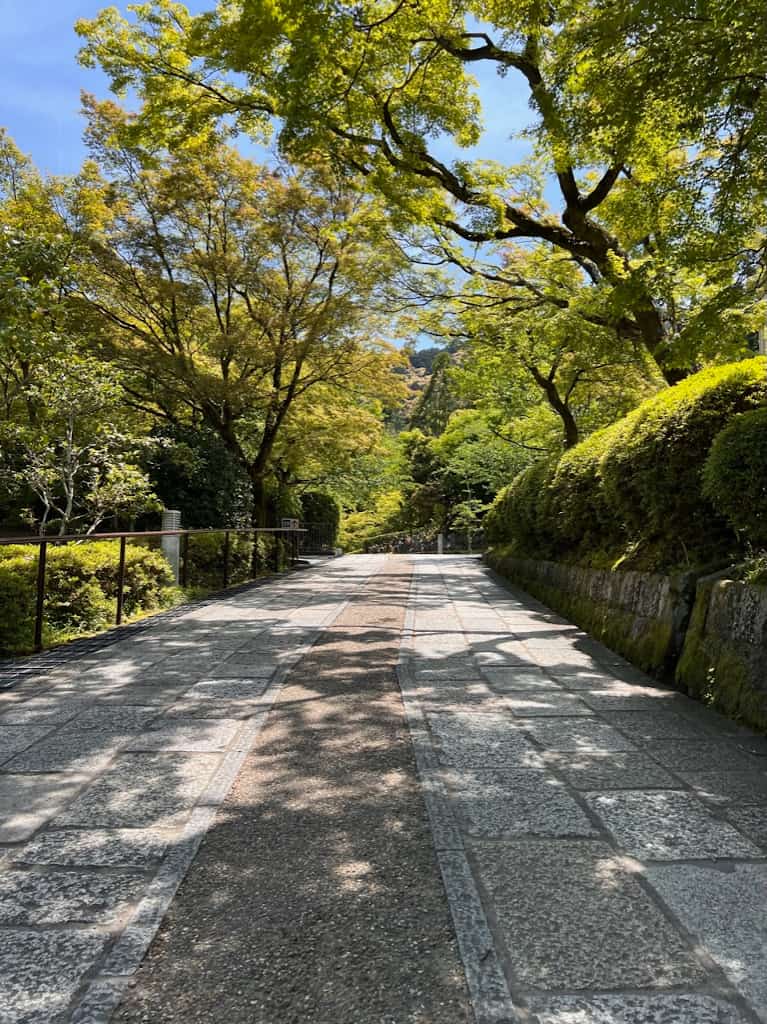
Versus what I see: The Kiyomizu-dera (Kyoto) back entrance that is wheelchair accessible | Photo: Cati Van Reeth
Ninenzaka and Sannenzaka streets
Ninenzaka is a steep piece of road and Sannenzaka will not be accessible due to stairs, simple as that, but the parts that are accessible are plentiful. You’ll for sure be able to take that iconic picture with the Hokanji pagoda.
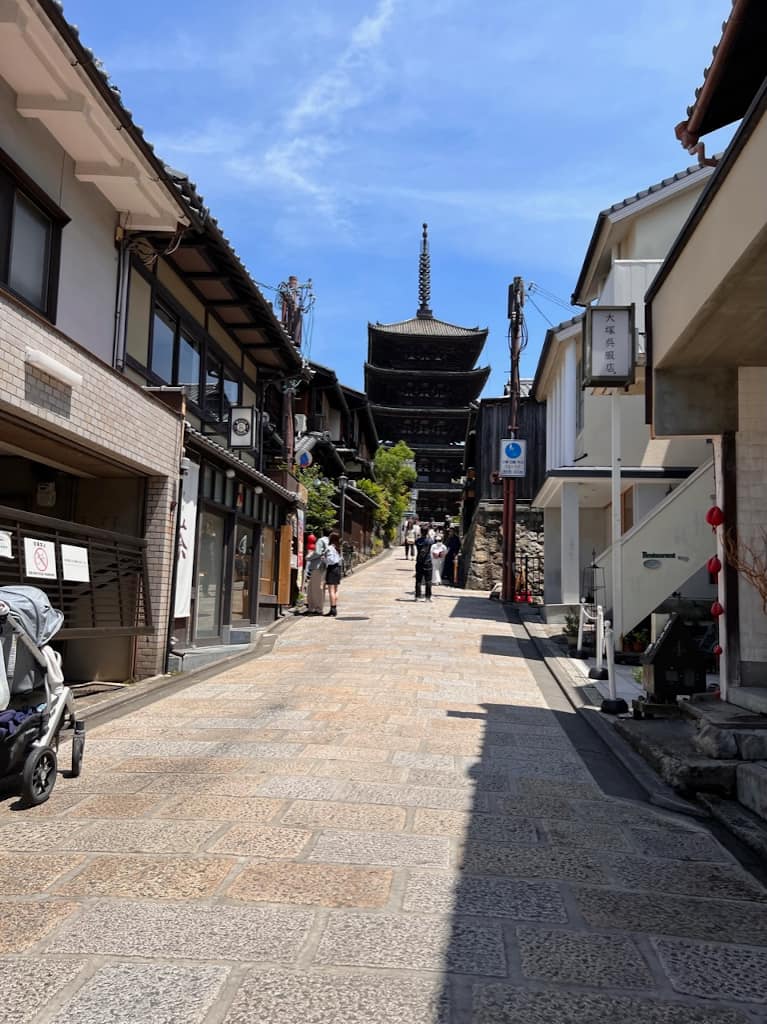
Accessible Ninenzaka street, Kyoto | Photo: Cati Van Reeth
Most shops are inaccessible and small, it really depends on how agile you are. For example, the Maccha House Maccha Kan had a narrow entrance with a bunch of uneven stones as pavement, to resemble a Japanese garden, but once you overcome that there’s no problem enjoying a nice matcha tiramisu.
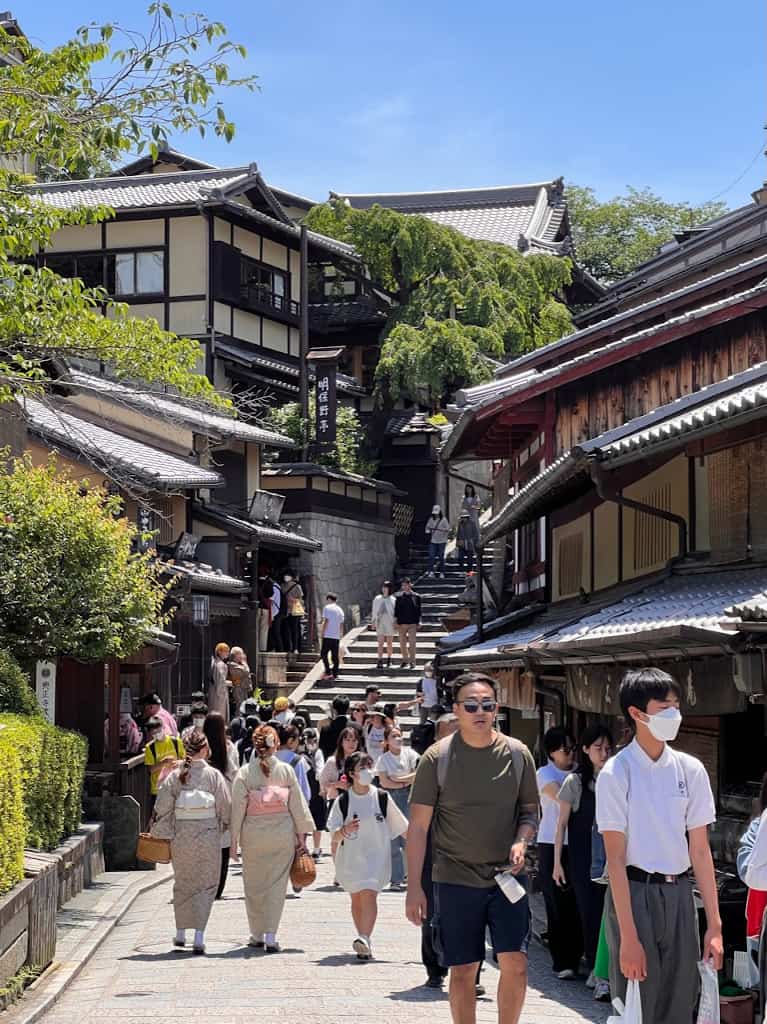
Inaccessible Sannenzaka street, Kyoto | Photo: Cati Van Reeth
Fushimi Inari Taisha
Fushimi Inari Taisha was one of the highlights of our trip. Believe it or not, but this is wheelchair accessible if you know where to go and how to bypass some bits, which you can later still do downwards if you have a skilled ‘driver’. There’s an elevator to get to the first part, but you’ll have to do some stairs if you want the experience everyone does.
However, there’s a path in the back, basically the halfway exit, that is without any stairs whatsoever. I recommend going up that way and making your way down through the Tori-gates. Sadly, for electric wheelchairs, it’s a little more complicated. It saddens me that certain people have to miss out on such a beautiful place, but I remain hopeful that in the future the Japanese will invent something that will definitely make it better!
Arashiyama bamboo grove, Sagano Romantic Train, and more
Arashiyama bamboo grove was actually quite underwhelming, mostly because of the heedless crowds and the fact it’s really not that big of an area to explore. We wanted to take the Sagano Romantic Train up the valley, but the station staff explained to us there were sixty steps to get down to the platform and that it was in no way wheelchair accessible, that was definitely a downer.
[An alternative, and wheelchair accessible, bamboo path in Kyoto is Take-no-michi ('Bamboo Path') in Muko. You can read more about that in this post: Valuable Insights From my 17th Trip To Japan (Includes 28 Day Itinerary).]
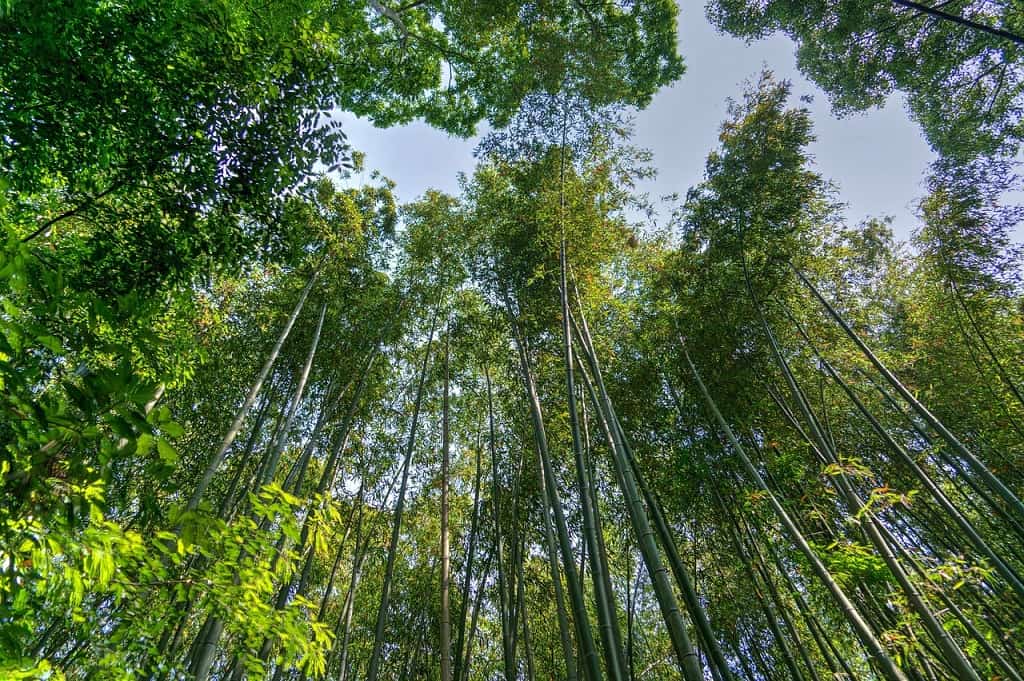
The famous Arashiyama bamboo grove was actually quite underwhelming
The Hozugawa river boats didn’t run at all during the week we were there, so then there’s that. We explored the park area instead, visited some shops and we had also booked a private onsen and nine-course kaiseki dinner at Hanaikada, a traditional ryokan. I had to leave the wheelchair at the entrance in order to take off our shoes and walk inside, so this is definitely not wheelchair accessible at all.
Also, to reach the onsen you had to climb a whole bunch of stairs. It was charming though, with a nice view, so we enjoyed it nonetheless. The nearby monkey park is, sadly, also inaccessible to wheelchair users as it is on top of a hill with steep paths and many steps.
Kinkakuji and Ginkakuji, Golden and Silver Pavilions
I would like to say they are accessible, but they’re not, at least partly.
With the Golden Pavilion (Kinkakuji) there are many stairs if you wish to do the full circle in the beautiful garden, but you could also go see the Pavilion and turn back the way you came, which means missing out on a third of the park, for which you paid to see. The Silver Pavilion (Ginkakuji) also has a beautiful garden and you can go see the pavilion, but there’s a part of the garden only accessible via stairs.
My husband quickly ran up there to take some photos of the amazing view.
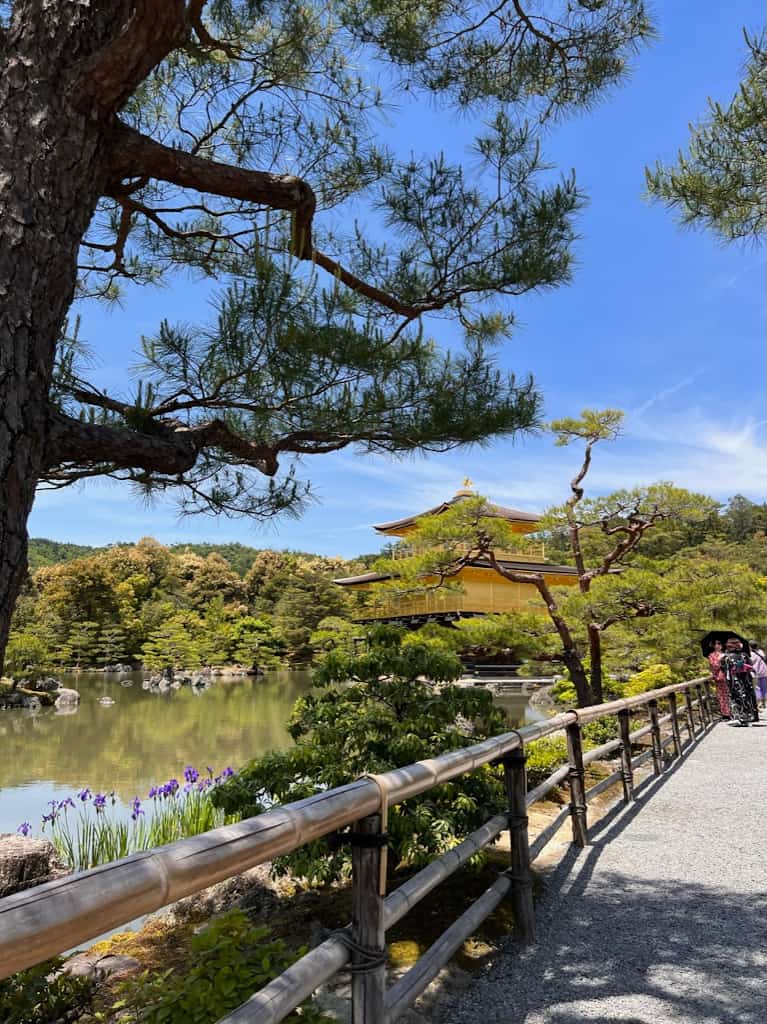
Gravel path to the Golden Pavilion, mostly not too deep to navigate if you have a skilled driver | Photo: Cati Van Reeth
Kyoto Imperial Palace
This is an interesting one. To get to the Kyoto Imperial Palace, you’ll have to face an incredible sea of gravel, so you’ll have to see if it’s worth it or not. Once inside the palace gates, you will be offered a wheelchair with electric assistance, so you’ll have to transfer into that, but it worked like a charm and we were able to do the whole tour around the grounds.
Philosopher’s Path
Don’t do it. I bet it's nice when the blossoms are blooming, and perhaps one small strip is worth a shot, but given all of the oncoming visitors and the uneven 'pavement' The Philosopher's Path is just not worth the hassle.
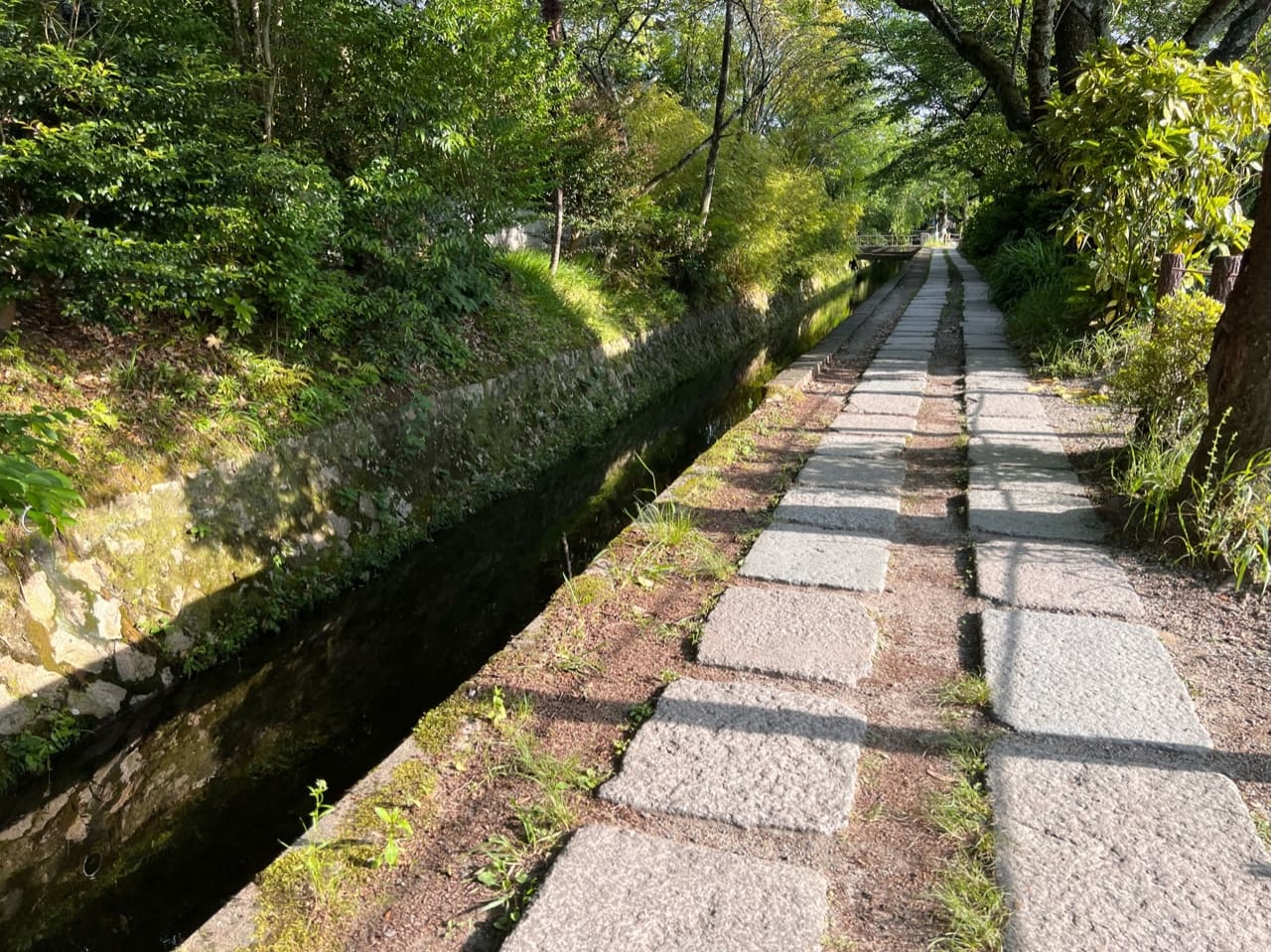
Enter the Philosopher’s path on wheels at your own risk! | Photo: Cati Van Reeth
Shunkaen Bonsai Museum
This bonsai garden in Edogawa was technically accessible, if it weren’t for those darn charming uneven pavement stones that make it a beautiful Japanese garden. I was lucky to be able to get up and walk around the place, as it was very calm.
Osaka accessible sightseeing tips
Osaka Castle
Osaka Castle is another must see in our view. Other visitors are dropped off at the top and must use the stairs to go down, but if you’re in a wheelchair, they will let you use the elevator at will. [ Entry is really cheap and you can buy tickets in advance from the Klook website. ]
Umeda Sky Building
This was cool, but they didn’t let me do the escalator that crosses the building way up high, which looks like a whole experience in itself. That was disappointing. [ There's more information on Umeda Sky Building in our Osaka City Guide. ]
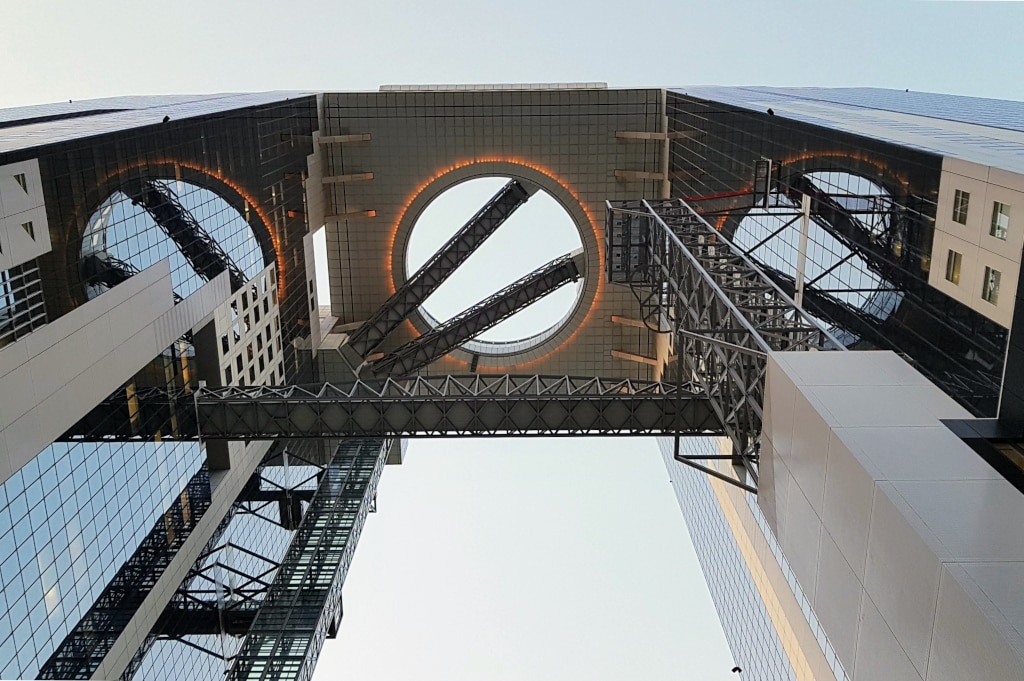
Umeda Sky Building is cool but wasn't completely accessible
TeamLab Botanical Garden
The staff at TeamLab Botanical Garden were very helpful, but one of the exhibits was inaccessible for wheelchairs. The installation features huge inflatable eggs (as tall as an average person) and they were wobbly and close together. You were supposed to touch them and they would change colour. But many young kids would kick them as hard as they could and that could make them tip over as they were only slightly attached to the ground.
If you’re unstable on your feet and someone kicks one of the eggs behind you, they could bump into you and make you fall. I wanted to get out of the chair and do that one bit on foot, but I am very unstable on my feet and visitors were quite rough with the eggs so I was nervous about getting bumped and falling over.
Universal Studios Japan (Osaka) / Disneyland/Disney Sea (Tokyo)
For Universal Studios Japan in Osaka we made no reservations in advance. We only ended up going to USJ simply because of the waiting times at Disneyland/Disney Sea.
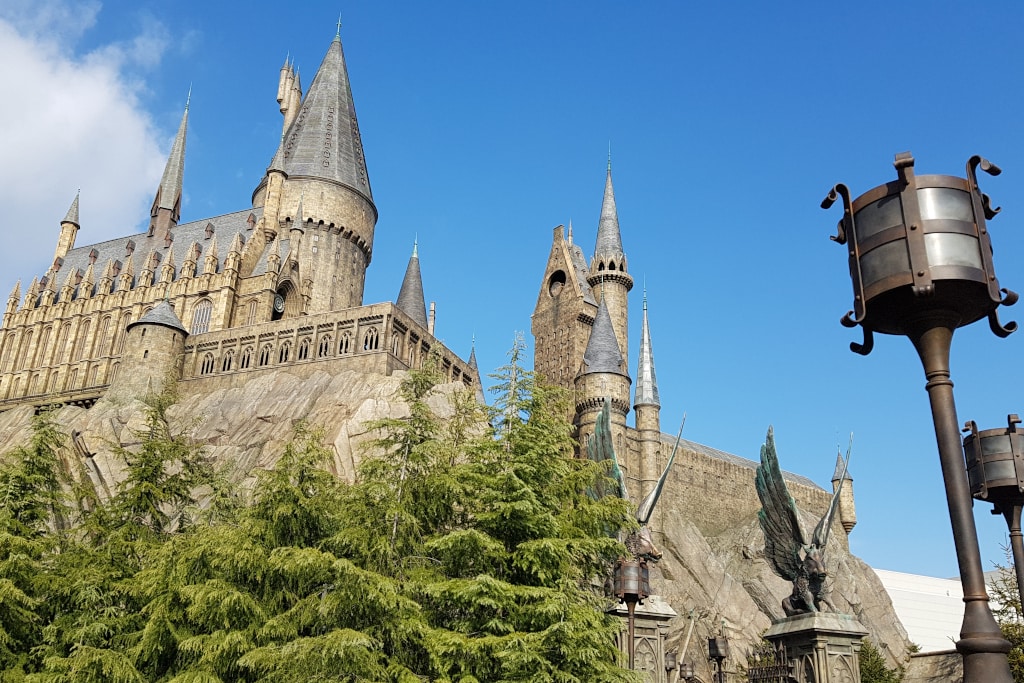
All of Universal Studios Japan is accessible but check descriptions in the official park app or with staff for full mobility info
At the park we picked the rides we wanted and all of it was accessible to me, but you should take a look at the descriptions in the official park app or check with the staff as not everyone has the same level of mobility. We went to the DisneySea counter but ended up exploring more of Tokyo instead, as we had already spent a day queuing at USJ the week before.
SEE ALSO: Osaka City Guide
Kobe accessible sightseeing tips
Nunobiki Herb Garden and Ropeway
A beautiful garden and very accessible, but you have to know where to go. The entrance we used is next to the shopping centre, on Kitano street, near Sandwich Bakery Fork. There you take the elevator or escalator, whichever you prefer, and you’ll find the ropeway (see video below).
At the gardens you will also be offered an electrically assisted wheelchair, as the path down is very steep. Don’t forget to stop at the herbal foot bath, with a lovely view over Kobe! [ Klook sells an all-inclusive Admission and roundtrip Ropeway ticket if you want to reserve in advance. ]
VIDEO: Riding Nunobiki Herb Garden Ropeway, Kobe
Mt. Fuji accessible sightseeing tips
Fuji-Go Q Tour
We booked the Fuji-Go Q tour via Airbnb. This is an absolute winner for an experience to explore the Lake Kawaguchiko shores with restored electric mini cars. Our guide was from South Africa and English-speaking, very well-travelled and has a Japanese wife, now living in Kawaguchiko and knows all about the area and the culture. Another highlight of our vacation, slightly expensive, but worth it. Check it out on Airbnb and let the reviews speak for themselves. [ NOTE: A driver's licence is required and an International Driving Permit is best. ]
Kachi Kachi Ropeway
For us, the Kachi Kachi Ropeway was just a tourist trap. You’re queuing to get up there. You’re queuing to take pictures of Fuji-san. You’re queuing even longer to get down again. And the best part is, it’s not wheelchair accessible at all. The staff will be confused if you say you can get up and walk a bit and they’ll let you go up there, but trust me, it’s really not worth your effort.
We also wanted to go to a kabuki performance at a kabuki theatre, as I had researched that it would be wheelchair accessible, but they didn’t sell any single act tickets for the time being. You should definitely research this beforehand.
Extra accessibility info about all of these spots
The general rule of thumb is that there are accessible toilets mostly everywhere, so there's no stressing about being able to find a spacious restroom, the same goes for elevators. People will be respectful and make room or help you without even needing to ask, except sometimes tourists. As long as we stay thankful and humble, the Japanese will return the favour and take good care of you.
Asking for a disability discount
I would like to encourage all people with an officially diagnosed disability to enquire about a disability discount, everywhere. It’s only advertised a handful of times, but we learned halfway through our trip that most places do offer a discount when you show them official proof of your disability.
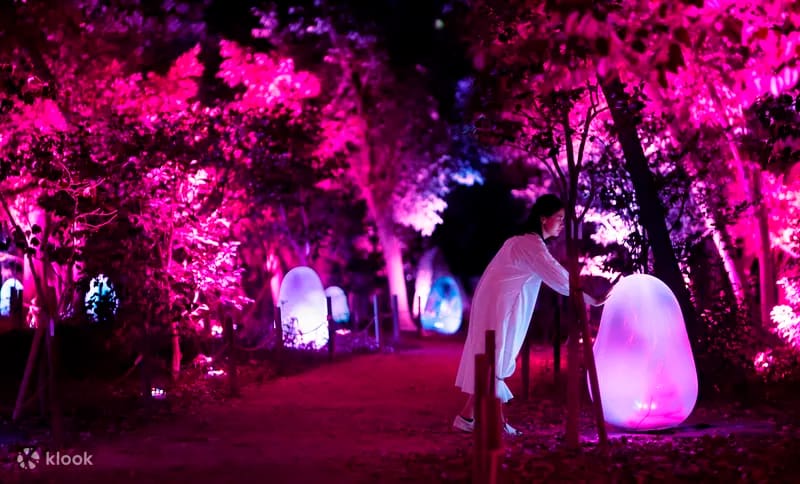
Teamlab Botanical Garden Osaka | Photo: Klook
As a European, I have a blue European Disability Card and we were only denied the discount on one occasion which was at the Diamond and Flower Ferris Wheel in Kasai Rinkai Park on Odaiba’s seaside. They wanted to see an official Japanese Disability Card, which we obviously don’t have. So please, however awkward it may feel, just ask.
Chances are that some parts of the exhibit or whatever you’re out there to experience, will be different for you from the chair. Best example would be the TeamLab Botanical Garden, there was one specific area that was not wheelchair accessible and we needed to bypass. Tuck away your reluctance and save some money, which you will most likely have to spend on transportation anyway.
Conclusion - being disabled and adventurous
I wanted to make a useful contribution to the internet. Hopefully this will help even a few adventurous souls out there, abled and disabled alike. If you’re the former, this could be eye-opening and I invite you to be mindful about the things you are maybe taking for granted. It could put things into perspective for all of us.
If you’re the latter, I can only conclude this post with one thing: just do it, take the leap and you’ll be rewarded. I’d choose Japan again in a heartbeat. We’re definitely going back at some point.
Thank you for reading, and ganbatte!

About the Author
Cati and Nick are a newlywed couple from Antwerp, Belgium, who share a mutual love for Japanese culture, so they decided to go on honeymoon to Japan. As Japan turned out to be an overwhelmingly accessible country, they decided to share their experiences and encourage others to take the leap.
Resources
Our Accommodation
Accessible Japan website
https://www.accessible-japan.com/
Accessible Japan Essential Japanese Phrases
Essential Japanese Phrases and Words for People with Disabilities
Japan Ministry of Health, Labour and Welfare
Assistance Dogs for Persons with Physical Disabilities
Information for those who are bringing medicines for personal use into Japan
More Itinerary Ideas
2 Week Tour of Chugoku: Easy 16 Day Itinerary
5 Days In Kyushu: An Unforgettable Itinerary
Our First Trip To Japan: 16-Day Itinerary & Review
Tokyo, Kyoto & Hiroshima (Book Review) Must Buy?
Valuable Insights From my 17th Trip To Japan (Includes 28 Day Itinerary)
More Experience Resources
My List of Recommended Japan Travel Resources
If you enjoyed this article please share this image online:


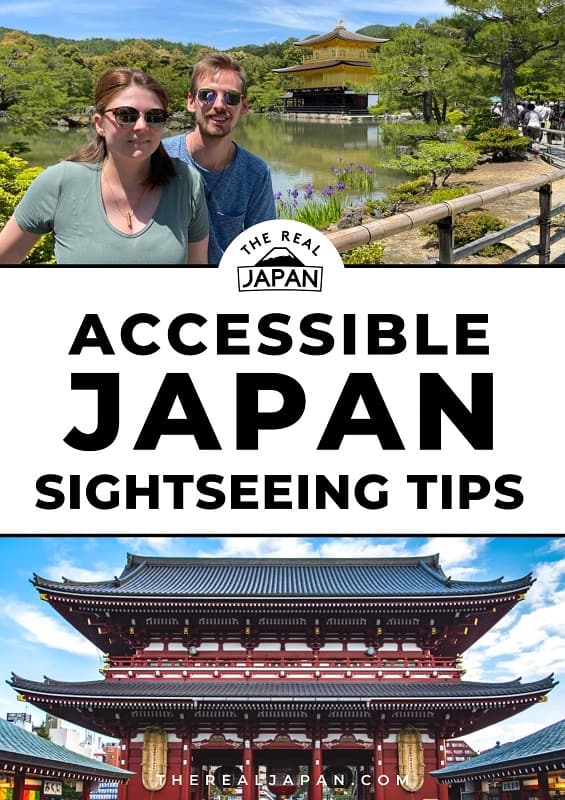
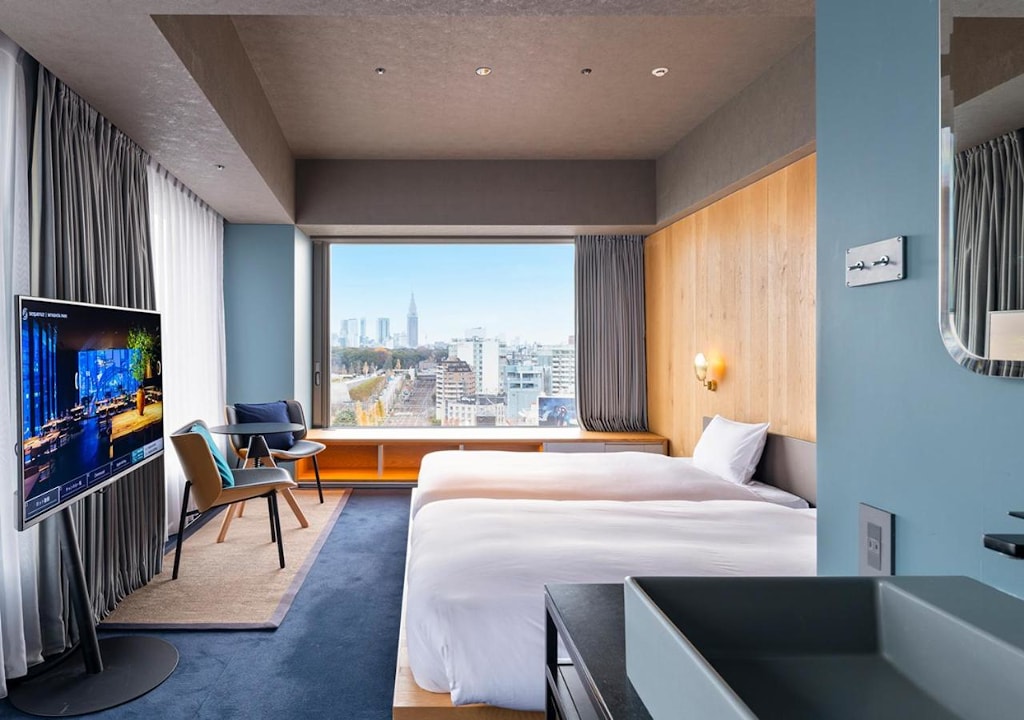



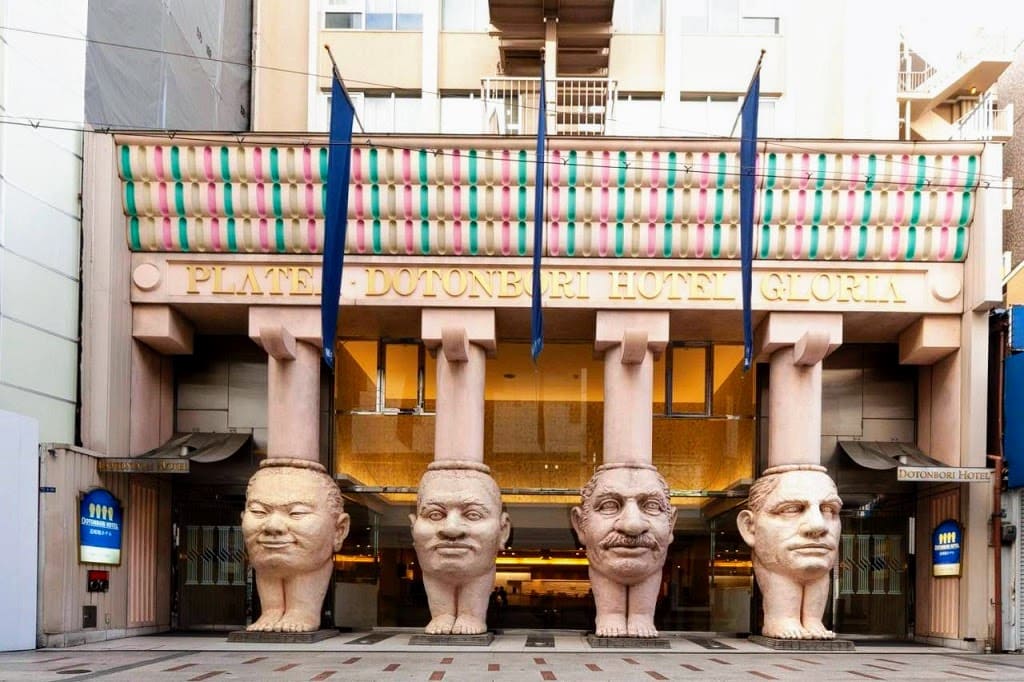
Thank you so much for your post, I am temporarily disabled in a wheelchair due to a triple ankle fracture. We decided not to cancel our trip to Japan. This article is very helpful to us, as my husband will be pushing me, ( we are 71) I have absolutely no weight bearing on the foot. We will have a manual folding wheelchair while traveling. How was Nara? We wish to go there from Kyoto. We will be in Kyoto 5 nights and Tokyo 6 nights after a 2 week cruise. I am learning to appreciate the difficulties of accessible travel – Grandma Judi
Wonderful tips and story.
Sorry that you had to miss out on some occasions that you were looking forward to, but I was more inspired by you and your husband’s activeness and had some fun here in Japan!
If it’s OK I would like to translate some in Japanese for Japanese people too! as I’m sure. there’s more people having the same worries as a local.
Thanks for sharing your thoughts Chinatsu, like you, I was impressed by how much Cati and Nick were able to include in their trip.
Thanks for asking about translation some of this post, rather than you doing that (just in case something gets ‘lost in translation’), you can send people to this post by simply using Google translate to give you a link that translates this page from English to Japanese. Here’s the link: https://translate.google.com/?sl=en&tl=ja&op=websites
This is totally fascinating. I lived in Japan for many years and then went back to visit this past February. I saw a few people in wheelchairs during my two-week visit, but noticed that none of them were alone. All had someone to push, which suggested to me that Japan may not yet really have independence in mind as a goal for those with mobility issues.
Thanks for this great resource.
Thank you Elizabeth for your your kind words and for sharing your thoughts.
This was a great read! I’ll pass some of the info on to my brother. He’s thinking about a trip to japan but has some mobility issues.
Thanks Karen – please do share with your brother. Hope he finds it helpful.
Hi there, Your information is very helpful. Thank you. I’m not in a wheelchair but have osteoarthritis and can’t walk long distances without sitting down. I am taking a collapsible stool with me for my first visit to Japan next year. Something you didn’t mention here that I’m looking at is rickshaw rides. I did some in Spain last year and they’re a great way to get around. I know they have them in Asakusa Tokyo, Arashiyama Kyoto and in Nara. They’re usually outside train stations. If going to Hiroshima and getting the ferry to Miyajima Island they have them there at the pier. Thought this might be helpful for those with knee pain.
Hello Irenke, thanks for sharing your experience and the idea of using rickshaw to get around for those with any knee pain. Nice idea!
You’re welcome. I know there’s a lot of walking in Japan from remarks I’ve seen on different Facebook groups.
Yes, you can find rickshaw rides pretty much everywhere in Japan at the popular hotspots! The only reason we didn’t try it is because we couldn’t figure out where to leave the wheelchair…